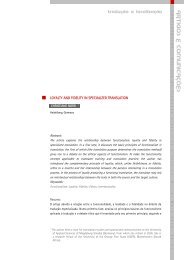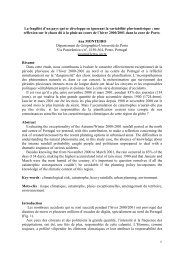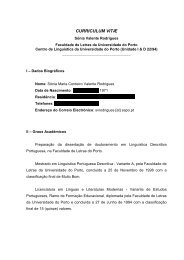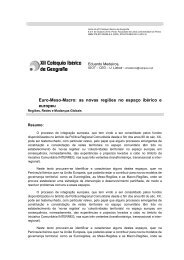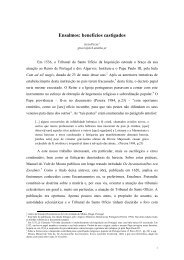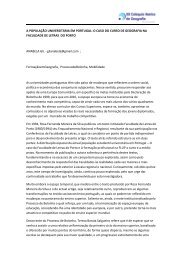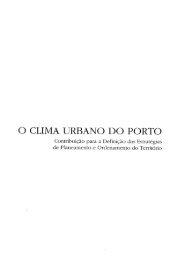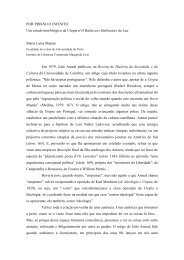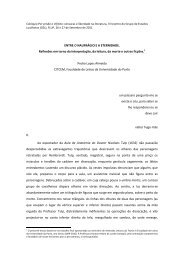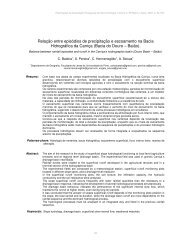Translators as hostages of history
Translators as hostages of history
Translators as hostages of history
Create successful ePaper yourself
Turn your PDF publications into a flip-book with our unique Google optimized e-Paper software.
TRANSLATORS AS HOSTAGES OF HISTORY<br />
THEO HERMANS / UBALDO STECCONI<br />
This is a provisional print version <strong>of</strong> the speech given by the authors in Luxembourg<br />
and Brussels on 17 and 18 January 2002. Sections set in Garamond are by Pr<strong>of</strong>. Hermans,<br />
sections set in Verdana in two columns are by Mr. Stecconi.<br />
1 Introduction<br />
CONTENT:<br />
1 Introduction<br />
2 Antiquity<br />
3 Renaissance<br />
4 Romanticism<br />
5 The Twentieth Century<br />
Bibliography<br />
Are translators born meek, do they acquire<br />
meekness, or do they have meekness thrust upon<br />
them?<br />
The question may seem inappropriate or<br />
even <strong>of</strong>fensive in present company, but published<br />
interviews, questionnaires and statements provide<br />
ample evidence <strong>of</strong> both pr<strong>of</strong>essional and more<br />
occ<strong>as</strong>ional translators consistently describing their work in terms <strong>of</strong> voluntary servitude,<br />
c<strong>as</strong>ting themselves in supportive and deferential roles <strong>as</strong> humble servants or handmaidens<br />
obeying their m<strong>as</strong>ters, <strong>as</strong> discreet, unobtrusive and self-denying facilitators, mediators, enablers,<br />
go-betweens, bridge-builders and the like.<br />
This text presents some <strong>of</strong> the metaphors, images and self-images used to describe<br />
translation and its practitioners through the ages. It is about perceptions and understandings <strong>of</strong><br />
translation, including the self-perceptions and self-understandings <strong>of</strong> translators. In other<br />
words, it is not so much about translation <strong>as</strong> about ide<strong>as</strong> about translation.<br />
That means it will be no more than tangential to<br />
the dialy routines <strong>of</strong> the European Commission’s Service de Traduction.<br />
What I have to say will not help to solve terminology problems or<br />
improve production statistics. Personally I am perfectly happy<br />
with my intervention – and the ‘Theory Meets Practice’ series into<br />
which it fits – being marginal to the pr<strong>of</strong>essional EU translators’<br />
day-to-day work. At le<strong>as</strong>t it avoids the nagging suspicion among many<br />
translators that theorists are somehow trying to impose rules or<br />
norms or particular modes <strong>of</strong> translating on them. I have no such<br />
desire. In my view, the theoretical and historical study <strong>of</strong> translation<br />
stands to the practice <strong>of</strong> translation <strong>as</strong>, say, art <strong>history</strong> or<br />
literary theory stand to modern painting or to writing novels. The<br />
art historian does not tell a painter how to paint; a narratologist does<br />
not tell Salman Rushdie how to write novels. The academics add to<br />
the painters’ and the writers’ work by reflecting on it.<br />
So, rather than tresp<strong>as</strong>sing on the pr<strong>of</strong>essional translator’s territory by seeking to<br />
interfere with the practice <strong>of</strong> translation, I am hopeful that the kind <strong>of</strong> academic study in which<br />
I engage can, ideally, add something – something extra and therefore optional, but potentially<br />
rewarding nevertheless.<br />
Perhaps the most important thing it can add is an incre<strong>as</strong>ed self-consciousness on the<br />
part <strong>of</strong> translators, a self-awareness that springs from the realization that the way in which we<br />
commonly speak and think about translation here and now is not the only possible way.<br />
Indeed various alternative vocabularies have been acted out in the course <strong>of</strong> <strong>history</strong>, <strong>as</strong> we will<br />
see. Exploring these alternatives, these different figurations <strong>of</strong> translation, brings home the<br />
contingency <strong>of</strong> our current modes <strong>of</strong> thinking. It highlights the diversity and complexity <strong>of</strong><br />
translation through the ages. It makes us aware <strong>of</strong> the pr<strong>of</strong>oundly metaphorical nature <strong>of</strong> our<br />
1
current terminology (source text, target text, bridge-building, service industry,…). It allows us<br />
to appreciate the significance <strong>of</strong> that terminology. Above all, it reminds us that shifting the<br />
vocabulary, changing the metaphors, allows us to re-describe and thus to re-think translation.<br />
That exercise will hopefully prove refreshing. Whether it leads to greater job satisfaction, to a<br />
heightened critical alertness or even to a more politicized attitude is for you to decide.<br />
What I want to do, then, is to trace some <strong>of</strong> the metaphors <strong>of</strong> translation and their<br />
historical deployment, <strong>as</strong> a way <strong>of</strong> probing not just into the nature <strong>of</strong> translation, but into how<br />
it h<strong>as</strong> been perceived, into its social construction.<br />
While preparing for this session,<br />
Theo and I decided we would tweak<br />
the usual format a little. Normally,<br />
when two speakers are invited to the<br />
Theory Meets Practice series—or to<br />
other events, for that matter—one<br />
begins to talk when the other is over.<br />
But because <strong>of</strong> our different roles—<br />
Theo is a leading translation scholar<br />
and historian, I am an <strong>of</strong>ficial with a<br />
scholarly p<strong>as</strong>t—we thought we could<br />
intertwine our presentations in a<br />
contrapunctal session. I will try to<br />
bring Theo’s insights and statements<br />
into our own right after they come to<br />
you, rather than waiting for him to<br />
finish and then recalling all the points<br />
I would like to develop.<br />
So, Theo w<strong>as</strong> talking about translation<br />
metaphors <strong>as</strong> probes into the nature<br />
<strong>of</strong> translation and <strong>as</strong> indications <strong>of</strong><br />
how translation is perceived socially.<br />
The importance <strong>of</strong> translation<br />
metaphors and, more generally, <strong>of</strong><br />
what we say about what we do at the<br />
SdT cannot be overestimated. Our<br />
service h<strong>as</strong> a unique position: it is<br />
very large, perhaps the largest<br />
translation bureau ever; it h<strong>as</strong> a long<br />
tradition; it is extremely structured<br />
and exceptionally well funded. In fact,<br />
it is large and structured enough to<br />
constitute perhaps an independent<br />
social aggregation all by itself.<br />
Because <strong>of</strong> this, it seems that each <strong>of</strong><br />
us—from the newly hired practitioner<br />
(<strong>of</strong> which I am one) to our top<br />
managers—h<strong>as</strong> perfectly defined roles<br />
and t<strong>as</strong>ks. This may produce the<br />
feeling that we all know perfectly well<br />
what to do and how to do it; the only<br />
issues open to debate being how to<br />
translate ‘governance’ into Portuguese<br />
2<br />
or who will replace the unit head when<br />
she retires.<br />
This is dangerous for several re<strong>as</strong>ons.<br />
Firstly, even though the machine<br />
worked like clockwork, it would still be<br />
our responsibility to constantly<br />
improve it; secondly, the service<br />
should be flexible enough to respond<br />
to external shocks, and the current<br />
administrative reform and<br />
enlargement round are big shocks<br />
indeed; thirdly, not all is well in the<br />
house, really: if you become<br />
complacent, defending yourself against<br />
criticism may become difficult and you<br />
end up losing the battle.<br />
But these are not going to be my main<br />
concerns. Theo just pointed out that<br />
looking at ide<strong>as</strong> about translation helps<br />
you become more aware <strong>of</strong> what you<br />
are doing. I would go one step further:<br />
looking at ide<strong>as</strong> about translation helps<br />
you better understand what you are<br />
doing. To illustrate the difference think<br />
<strong>of</strong> Sir Isaac Newton; everyone w<strong>as</strong><br />
aware <strong>of</strong> gravity before his studies,<br />
but only after him can we say we<br />
began to understand what gravity is<br />
about.<br />
So, I present my contrappunti mainly<br />
<strong>as</strong> an intellectual quest. As if this were<br />
not interesting enough, let me add<br />
that there is nothing I despise more<br />
than knowledge staring at its own<br />
navel. Therefore, I will devote some<br />
notes to what we can do with our new
understanding. These are going to be<br />
the political bars in my score. Some<br />
will look outlandish, others<br />
provocative and quite deliberately so;<br />
because the point <strong>of</strong> the exercise is to<br />
fuel a fresh debate within the SdT.<br />
So, here comes my opening salvo. I<br />
propose we start a structured search<br />
for the figurative metalanguage on<br />
translation that circulates in the SdT. I<br />
would like to see a smart collection <strong>of</strong><br />
the images we use within the Service<br />
to talk about our translating and<br />
translations. The effort could be<br />
coordinated with other translation<br />
services across the institutions and<br />
could produce a commented inventory<br />
<strong>of</strong> claims, remarks and quips that<br />
appear in <strong>of</strong>ficial, formal, and informal<br />
communication.<br />
Theo’s presentation could serve <strong>as</strong> our<br />
starting point. In fact, while preparing<br />
for this joint session, he already<br />
suggested to me that we give the<br />
search a historical slant. Looking into<br />
the metalanguage <strong>of</strong> the SdT over the<br />
l<strong>as</strong>t few decades, one would probably<br />
find shifts reflecting the changing<br />
perception <strong>of</strong> the role and significance<br />
<strong>of</strong> translation within the entire<br />
European project. For example,<br />
metaphors shifting from economic to<br />
cultural and political issues.<br />
Finally, it h<strong>as</strong> been observed that<br />
translation figures very little in the<br />
wider communication within the<br />
Commission and the other<br />
institutions; in fact, it seems we are<br />
taken very much for granted. The<br />
search would also include those c<strong>as</strong>es<br />
2 Antiquity<br />
3<br />
where translation issues should be<br />
raised and are not. Thus, we would be<br />
looking for both the presence and the<br />
absence <strong>of</strong> translation metaphors—for<br />
both the cheese and the holes, <strong>as</strong> it<br />
were—silence being itself a powerful<br />
figure <strong>of</strong> speech.<br />
As to the political<br />
side <strong>of</strong> this<br />
enterprise, I<br />
would like to<br />
invite more<br />
experienced<br />
colleagues to say<br />
whether they have<br />
a feeling our<br />
metalanguage h<strong>as</strong><br />
changed over the years. I am sure the<br />
problems the SdT had to solve 10 or<br />
20 years ago were <strong>of</strong> a different scale<br />
and nature than today’s. Evidence <strong>of</strong><br />
p<strong>as</strong>t change and evolution in our<br />
discourse about translation would be<br />
an encouraging sign; it would indicate<br />
we can rise to the challenges that the<br />
future holds for us. As indicated<br />
above, the SdT will be m<strong>as</strong>sively<br />
affected by the on–going<br />
administrative<br />
reform and by<br />
enlargement. This<br />
historical juncture<br />
requires vision<br />
and a high degree<br />
<strong>of</strong> flexibility. The<br />
ability to reflect<br />
on our own<br />
tropes is essential if we are to develop<br />
a pro–active attitude that would lead<br />
the change rather than respond to it<br />
defensively.<br />
What follows is a canter through the figurative metalanguage <strong>of</strong> translation in some<br />
West European traditions, starting with the observation that in several European languages the<br />
term for translation itself carries an obvious metaphorical load, visible in the etymological<br />
derivation from (or<br />
sometimes translation<br />
<strong>of</strong>) Latin translatio,<br />
transferre: to carry or<br />
ferry across, to<br />
relocate. The spatial<br />
sense <strong>of</strong> physical<br />
movement and<br />
transport is obvious. It<br />
should make us<br />
wonder, incidentally,<br />
to what extent the<br />
term itself already<br />
appeals to a metaphor<br />
which conditions us to<br />
think <strong>of</strong> translation <strong>as</strong>
involving some load or freight (meaning?) being transported (how?) from one place to another<br />
in some kind <strong>of</strong> vessel or container (language?); I will come back to this below.<br />
Let us begin, then, with the Romans, the creators <strong>of</strong> what been called ‘the first<br />
copying culture in the West’. An interesting complication right from the start is that the Latin<br />
term translatio, which itself translates the Greek µεταφoρά, means both ‘translation’ and, <strong>as</strong> a<br />
rhetorical term, ‘metaphor’ or displacement. In this latter sense it is used in handbooks <strong>of</strong><br />
rhetoric to refer to the shift from literal to figurative meaning. A Roman could use translatio <strong>as</strong><br />
a rhetorical term to denote the switch from normal, ‘proper’ discourse to figurative, ‘improper’,<br />
‘displaced’ speech, and then translate that ‘deviant’ mode back into the - presumed - normal,<br />
unproblematic designations <strong>of</strong> everyday language.<br />
The two meanings <strong>of</strong> translatio <strong>as</strong> ‘relocation <strong>of</strong> meaning’ and <strong>as</strong> ‘metaphorical<br />
displacement’ are both predicated on a combination <strong>of</strong> similarity and difference, but their<br />
closeness does not appear to have been commented upon by Roman writers. One re<strong>as</strong>on for<br />
this is that the Romans were less interested in translation than in its more glamorous cousin<br />
imitatio, imitation. Translation is put in its place by its <strong>as</strong>sociation with imitation, and it is<br />
imitation which attracts the more colourful metaphors.<br />
Both translation and imitation are forms <strong>of</strong> mimesis. They copy the external world,<br />
and <strong>as</strong> such they are engaged in producing similarity. Like shadows or portraits, they are meant<br />
to resemble something – a body, a substance, a model - which exists outside themselves and<br />
which w<strong>as</strong> there before them. And <strong>as</strong> Quintilian says: “whatever is like another object must<br />
necessarily be inferior to the object <strong>of</strong> its imitation, just <strong>as</strong> the shadow in inferior to the<br />
substance, the portrait to the features which it portrays.”<br />
But translation and imitation produce resemblance in different ways. Translation is<br />
ranged with grammatical exercises like paraphr<strong>as</strong>ing texts to show you have understood their<br />
grammatical structure and are able to unlock their meaning. Like the school exercises we all<br />
used to do, these translations are not allowed to stray from the straight and narrow but must<br />
exactly follow “the footsteps <strong>of</strong> the Greek”, <strong>as</strong> Horace puts it. That insistence on closeness and<br />
constraint explains why the ‘faithful’ translator, fidus interpres, comes to mean the timid, dull or<br />
slavish translator who is faithful to the letter.<br />
By contr<strong>as</strong>t, the figurative metalanguage <strong>of</strong> Cl<strong>as</strong>sical imitatio is much richer and<br />
altogether bolder. It stresses difference and disjunction alongside similarity and continuity. The<br />
metaphors expressing this differential <strong>as</strong>pect <strong>of</strong> imitation fall broadly into three cl<strong>as</strong>ses, all <strong>of</strong><br />
them carrying a distinctly appropriative and conflictual element. They are<br />
dissimulative metaphors, which e.g. urge writers to conceal the traces <strong>of</strong> the<br />
models they are imitating;<br />
transformative metaphors, e.g. images <strong>of</strong> swallowing and digestion, transforming<br />
food into nourishment; or the likeness <strong>of</strong> parent to child; or <strong>of</strong> bees collecting<br />
pollen from flowers and transforming it into honey <strong>as</strong> they return to the hive (<strong>as</strong><br />
indeed the Romans believed bees did); and<br />
agonistic metaphors, such <strong>as</strong> racing against an opponent (rather than walking in<br />
exactly in his footsteps, <strong>as</strong> translators do!) or wrestling with him, or otherwise<br />
trying to outdo or surp<strong>as</strong>s a pre-eminent predecessor.<br />
For all their difference,<br />
translation and imitation are not worlds apart. They are<br />
contiguous categories, and may even overlap. Both<br />
operate in a political context in which Roman military<br />
and political dominance over Greece sharply<br />
contr<strong>as</strong>ts with a sense <strong>of</strong> cultural dependence,<br />
resulting in ambivalent attitude towards Greek<br />
culture and a conscious drive among Rome’s<br />
cultural elite to appropriate Greek culture by means <strong>of</strong><br />
imitation, translation and transposition. Horace and<br />
Cicero advocate forms <strong>of</strong> aggressive imitation aimed<br />
at replacing the Greek models with Roman ones<br />
which although derived from the Greek seek to<br />
make the latter redundant.<br />
This is, for example, what<br />
Cicero proposes in ‘On the Best Kind <strong>of</strong> Orator’ (De<br />
4
optimo genere oratorum), a short text which serves <strong>as</strong> a preface to his Latin version <strong>of</strong> two Greek<br />
orations written in a particular style. “I could have rendered these texts <strong>as</strong> a translator,” Cicero<br />
writes, “but instead I chose to render them <strong>as</strong> an orator”. Although he uses the same verb<br />
(convertere) to indicate both operations, he h<strong>as</strong> on this occ<strong>as</strong>ion opted to go about the job ‘<strong>as</strong> an<br />
orator’.He h<strong>as</strong> therefore not just translated the words, because that kind <strong>of</strong> docile wordprocessing<br />
would be unable to see the wood for the trees, but he h<strong>as</strong> added stylistic vigour and<br />
refinement, and re-moulded the text in its entirety. Put metaphorically: “I did not think I ought<br />
to count [the words] out to the reader like coins, but to pay them by weight, <strong>as</strong> it were.” In<br />
suggesting the idea <strong>of</strong> overall equivalence rather than the translator’s laborious one-to-one<br />
correspondence, the image <strong>of</strong> payment by means <strong>of</strong> a single lump sum enacts the process<br />
whereby the new version comprehensively supplants its original - and thus deliberately<br />
obscures it. By translating <strong>as</strong> he does Cicero furnishes a properly Latin model for <strong>as</strong>piring<br />
Roman orators, who <strong>as</strong> a consequence will no longer have any need <strong>of</strong> the Greek originals.<br />
Saint Jerome, patron saint <strong>of</strong><br />
translators, thinks about translation in<br />
roughly similar ways. In his famous<br />
‘Letter to Pammachius’ (also known <strong>as</strong><br />
‘On the Best Kind <strong>of</strong> Translation’, de<br />
optimo genere interpretandi, written<br />
towards the end <strong>of</strong> the 4th century<br />
CE), he remarks that “a word-for-word<br />
translation conceals the sense, even <strong>as</strong><br />
an overgrown field chokes the gr<strong>as</strong>s”,<br />
and points out that, before him, Hilary<br />
the Confessor had likewise left “the<br />
sleepy letter” for what it w<strong>as</strong> and had<br />
instead “by right <strong>of</strong> victory led away<br />
the sense captive into his own<br />
language” – a strikingly appropriative<br />
and military kind <strong>of</strong> image.<br />
Terminological issues and faithfulness<br />
play a large role in the discourse<br />
about translation at the SdT; it’s <strong>as</strong> if<br />
we never overcame Jerome’s<br />
concerns. I will come back to both<br />
issues later. For the moment I would<br />
like to make a preliminary remark.<br />
We can use huge datab<strong>as</strong>es made <strong>of</strong><br />
words and short phr<strong>as</strong>es; we are<br />
given fixed one-to-one<br />
correspondences for certain lexical<br />
items; we are <strong>as</strong>ked not to use certain<br />
words, and we end up talking about<br />
translating <strong>as</strong> if we lived by words<br />
alone. I call this approach ‘word<br />
processing’; ie, believing that<br />
translating consists in replacing<br />
individual words in one language with<br />
other words in another.<br />
This approach is justified in terms <strong>of</strong><br />
standardisation, processing e<strong>as</strong>e,<br />
house style, <strong>of</strong>ficial register, etc.—<br />
which is very well, <strong>of</strong> course, and<br />
today Theo is telling us that ‘word<br />
processing’ comes from a distant p<strong>as</strong>t.<br />
However, justifying one’s translation<br />
word by word-—<strong>as</strong> even Cicero<br />
5<br />
refused to do—is pointless and self–<br />
defeating. You will never be able to<br />
successfully defend your<br />
translation from a<br />
sympathetic colleague or an<br />
enraged requester by<br />
pointing out that each and<br />
every word is equivalent to the words<br />
<strong>of</strong> the original according to guidelines,<br />
models and datab<strong>as</strong>es. It<br />
would be <strong>as</strong> if a conductor<br />
justified his rendition <strong>of</strong> a<br />
score note by note, a<br />
tailor the dress he sews<br />
stitch by stitch, or a cook his recipe by<br />
individual ingredients. These people<br />
use notes, stitches and ingredients to<br />
do something else: make delightful<br />
music, f<strong>as</strong>hionable dresses and t<strong>as</strong>ty<br />
plates respectively. We use words to<br />
produce clear<br />
and informative<br />
texts; these<br />
should be our<br />
main focus.<br />
Most Christian authors in late Antiquity and the early Middle Ages however are more<br />
cautious (and Jerome’s own practice too is more moderate and inconsistent that these few
images suggest). They distrust Cl<strong>as</strong>sical rhetoric, which they regard <strong>as</strong> extravagant and<br />
potentially corrupting. Instead, and especially when dealing with authoritative texts, they stress<br />
humble fidelity to a truth thought to reside in the very words used to express it. And just <strong>as</strong><br />
Jerome had insisted that in the Bible “there is mystery even in the order <strong>of</strong> the words” and it<br />
would not be permissible to tinker with it, the early Christian translators go for images <strong>of</strong><br />
integrity and non-intervention, supplemented with metaphors highlighting the translator’s selfsacrifice<br />
and <strong>as</strong>cetic self-denial in clinging to the original’s every word. They firmly tie the idea<br />
<strong>of</strong> the translator’s role and responsibility to that <strong>of</strong> strict philological ‘fidelity’, together with the<br />
opposite notions <strong>of</strong> disloyalty, falsification, distortion, unreliability, corruption and betrayal, all<br />
<strong>of</strong> which carry strong moral, political and ideological overtones. That is why, for instance, in<br />
the fifth century, Boethius is happy to accept “the blame <strong>of</strong> the faithful translator” and why <strong>as</strong><br />
late <strong>as</strong> the fourteenth century a French translator appeals to “the pure truth <strong>of</strong> the letter” in an<br />
attempt to avoid the responsibility <strong>of</strong> interpretation and with it the risk <strong>of</strong> misinterpretation.<br />
The reverse side <strong>of</strong> this coin is the translator’s refusal to accept censure for<br />
unintelligibility. If the source text is unintelligible, then so will the translation be: don’t shoot<br />
the messenger! When he w<strong>as</strong> criticized for a translation deemed to be <strong>as</strong> obscure <strong>as</strong> the<br />
foreign language <strong>of</strong> its original, the ninth-century translator John Scotus Eriugena replied: “I<br />
am only a translator, not an expositor” – the <strong>as</strong>sumption being that the translator is ‘merely’<br />
the messenger who refrains from interpreting what he reads and h<strong>as</strong> no creative input apart<br />
from matching words with words. On the whole the Middle Ages distinguish between<br />
‘translating’ and ‘glossing’ authoritative texts. It is in fact interesting to see that where<strong>as</strong> Roman<br />
culture set translation over against imitation <strong>as</strong> creative exercises, the Middle Ages contr<strong>as</strong>t<br />
translation and commentary <strong>as</strong> interpretive activities.<br />
The words <strong>of</strong> Scotus Eriugena seem to<br />
have a recurrent echo along these<br />
corridors. They open the door to the<br />
issue <strong>of</strong> faithfulness, which I would<br />
like to approach with a mild<br />
provocation. We can clearly use a<br />
debate on fidelity at the SdT. I<br />
presume no one will claim one can be<br />
faithful to the words<br />
<strong>of</strong> the original after<br />
reading Theo's part<br />
<strong>of</strong> the session. As a<br />
result, we should<br />
<strong>as</strong>k the question<br />
afresh: whom are<br />
we faithful to? Are<br />
we ultimately<br />
faithful to the<br />
European citizen<br />
6<br />
and his demands that the institutions<br />
talk to him in a clear and authoritative<br />
manner? Are we faithful to our clients<br />
in the DGs, who want their documents<br />
clean, f<strong>as</strong>t and uncritically crisp? Or<br />
perhaps we like to ple<strong>as</strong>e our bosses,<br />
who will become so crucial for our<br />
promotions in the years to come.<br />
Personally, I find it difficult to<br />
contradict the colleagues who were<br />
here before me and have left a mark<br />
on SdTvista, and all my sympathy<br />
goes to our terminologists, who are<br />
engaged in an impossible yet<br />
necessary t<strong>as</strong>k. The list can continue,<br />
but when it is long enough, a second<br />
question comes to mind: to whom or<br />
what should we be faithful, and why?<br />
This is beyond my means, honestly; I<br />
need your help here.<br />
3 Renaissance<br />
These distinctions are carried over into the Renaissance, which, being the heyday <strong>of</strong><br />
Europe’s translation culture, is also the era when the metaphors <strong>of</strong> translation come into ther<br />
own and begin to diversify. The Renaissance, <strong>as</strong> the word indicates, is also the period <strong>of</strong> the<br />
recovery and rediscovery <strong>of</strong> Cl<strong>as</strong>sical culture. In this context translation is <strong>of</strong>ten described at<br />
this time <strong>as</strong> bringing to light something valuable that had been lost or forgotten: digging up<br />
tre<strong>as</strong>ure, unlocking chests, hauling tre<strong>as</strong>ures back from overse<strong>as</strong>, even bringing someone back<br />
from the dead.<br />
Translation restores, and in so doing<br />
renders a public service because it puts previously<br />
inaccessible texts and ide<strong>as</strong> at the disposal <strong>of</strong> new<br />
constituencies. As translation into vernacular<br />
languages grows in volume and importance, the<br />
democratic <strong>as</strong>pect <strong>of</strong> this dissemination <strong>of</strong><br />
knowledge is stressed. “No man lights a candle to<br />
cover it under a bushel,” the English translator<br />
Thom<strong>as</strong> Eliot writes in 1544, and the image will be
epeated in the introduction to the King James Bible in 1609.<br />
That does not mean that translation is uncontroversial. We can glimpse the politics <strong>of</strong><br />
language at this time, when high culture still uses Latin rather than a vernacular, when the<br />
Latin-writing elite objects to translation into the vulgar tongues by speaking <strong>of</strong> it <strong>as</strong> a<br />
pr<strong>of</strong>anation <strong>of</strong> something sacred or valuable, <strong>as</strong> throwing pearls to the swine, <strong>as</strong> poisoning the<br />
commoners’ minds. Sometimes the objection applies only to translating the Bible into<br />
vernacular languages. At other times however it extends to those venerated texts thought to be<br />
too pr<strong>of</strong>ound or too complex for the ordinary person’s understanding. The images used to<br />
oppose the transposition <strong>of</strong> high culture into vulgar tongues will have a long life: translation <strong>as</strong><br />
importing dangerous goods or making them available to those unable to cope with them, leads<br />
to images c<strong>as</strong>ting translation <strong>as</strong> threatening our people’s innocence, <strong>as</strong> subverting authority, <strong>as</strong><br />
undermining the nation’s moral fibre, <strong>as</strong> waves <strong>of</strong> filth lapping at the nation’s shores - and<br />
hence to images <strong>of</strong> guarding against the pernicious influx <strong>of</strong> translations by means <strong>of</strong><br />
floodgates, defensive walls, dykes etc.<br />
The Latin–writing elites were resisting<br />
the potentially subversive power <strong>of</strong><br />
translation. The relation between the<br />
preservation <strong>of</strong> knowledge and that <strong>of</strong><br />
political power is general. The Spanish<br />
clergy who set out to evangelise the<br />
Philippines in the 16th century<br />
preferred the term Dyos to the<br />
existing native Bahala for ‘God’<br />
because they would better understand<br />
it; never mind the aboriginals, for<br />
whom the term w<strong>as</strong> incomprehensible.<br />
We are not totally exempt from this<br />
attitude either. Kaisa Koskinen pointed<br />
out in her “Institutional Illusions” (The<br />
Translator 6:1, 2000) that certain<br />
textual features, probably derived<br />
from French normative texts, survive<br />
in translation into Nordic languages<br />
although they cl<strong>as</strong>h with Northern<br />
European traditions. I can confirm<br />
that—on a purely lexical level—calque<br />
from French is the single most<br />
influential force behind Italian<br />
Eurospeak (eg, partenariato). It is<br />
altogether possible that policy makers<br />
and influential <strong>of</strong>ficials feel more at<br />
e<strong>as</strong>e if the various versions <strong>of</strong> their<br />
texts preserve traces <strong>of</strong> the French<br />
they use to talk to each other.<br />
However, our language policy is b<strong>as</strong>ed<br />
on multilingualism and<br />
multiculturalism. Only if we deliver in<br />
these respects can we hope to merge<br />
the different European traditions into<br />
one while respecting their characters.<br />
In more operational terms, the EU<br />
should communicate itself to all its<br />
constituents (and beyond its borders)<br />
in the terms <strong>of</strong> each receiving locale.<br />
In other words, it should localise itself.<br />
supposed to take to make money in<br />
today’s globalised economy. Such<br />
me<strong>as</strong>ures go well beyond translating<br />
manuals and help files; they include<br />
adding a transformer to electrical<br />
appliances for use across the Atlantic;<br />
preparing artefacts and documentation<br />
for different metrical systems; and<br />
banishing pictures <strong>of</strong> women from<br />
your website for Saudi Arabia. I would<br />
like to take the term and broad<br />
concept <strong>of</strong> localisation out <strong>of</strong> its<br />
corporate setting and apply it to our<br />
ultimate goal.<br />
The EU is an unprecedented political<br />
experiment whose setup and<br />
implications are terribly difficult to<br />
communicate, both within and without<br />
its borders. The difficulty is<br />
compounded by the various cultural<br />
and historical backgrounds <strong>of</strong> its<br />
inhabitants. EU policy–makers stress<br />
the common features <strong>of</strong> the peoples <strong>of</strong><br />
Europe all the time. They do well, <strong>of</strong><br />
course, because on this rest the<br />
chances <strong>of</strong> success <strong>of</strong> the European<br />
project. But the attitude should not<br />
turn into mindless optimism and<br />
sweep the differences under the<br />
carpet. Are we sure the debate over—<br />
say—sovereignty is understood in the<br />
same way in Greece and Denmark, or<br />
in Ireland and Britain for that matter?<br />
<strong>Translators</strong> are the first to know it is<br />
not. We are in a unique position to<br />
raise awareness <strong>of</strong> the features that<br />
are not common among the peoples <strong>of</strong><br />
Europe. Overlooking these different<br />
perceptions would be very dangerous<br />
for the success <strong>of</strong> our whole<br />
enterprise. When Brussels<br />
understands the lesson <strong>of</strong> localisation,<br />
The term ‘localisation’ is a recent translators will be an important<br />
buzzword in the pr<strong>of</strong>ession. It surfaced resource well beyond their traditional<br />
around ten years ago to indicate the role <strong>as</strong> rewriters <strong>of</strong> printed words.<br />
translation and adaptation <strong>of</strong> s<strong>of</strong>tware<br />
for non–English-speaking markets.<br />
From then on, it p<strong>as</strong>sed to indicate a<br />
series <strong>of</strong> me<strong>as</strong>ures companies are<br />
Believe it or not, we have always been<br />
something other than fine wordsmiths.<br />
I am convinced that—<strong>as</strong> a by–product<br />
7
<strong>of</strong> our daily practice—we have<br />
am<strong>as</strong>sed a wealth <strong>of</strong> communication<br />
skills and cultural sensitivity which<br />
other people may not suspect. In fact,<br />
I fear we are not aware <strong>of</strong> it ourselves.<br />
The skills we use and hone every day<br />
could be put to good use in many<br />
places even today. Press,<br />
Development, External Relations,<br />
EuropeAid and Enrlargement are the<br />
DG’s that first spring to mind. If we<br />
adopted a pro–active attitude, we<br />
could market our extra skills to them,<br />
thereby enhancing our status and<br />
safeguarding our future.<br />
One <strong>of</strong> the foci <strong>of</strong> Theo's text is that<br />
translation h<strong>as</strong> been defined<br />
throughout <strong>history</strong> with reference to<br />
other practices outside the remit <strong>of</strong><br />
translators. I propose we can use this<br />
relativistic insight to look for our<br />
additional skills <strong>as</strong> localisers, because<br />
there is an urgent need to turn<br />
Eurospeak into understandable and<br />
8<br />
persu<strong>as</strong>ive language. This may help us<br />
prove we don't 'merely translate', and<br />
may give us the opportunity to rise to<br />
the EU's democratic challenge. Such a<br />
project, in turn, implies a redefinition<br />
<strong>of</strong> the concept <strong>of</strong> translation prevalent<br />
in the SdT today and the intelligence<br />
and vision to give it political legs. In<br />
this way, our managerial staff will<br />
have an opportunity to prove its<br />
worth.<br />
I launch this idea also with an eye to<br />
the reform <strong>of</strong> personnel. It looks like<br />
the powers–that–be can no longer<br />
maintain the status quo for the<br />
Translation Service. When your<br />
traditional market position is<br />
threatened, the best thing to do is<br />
diversify. Our position is indeed<br />
threatened, therefore we must find<br />
something else to sell apart from<br />
words, and find it quickly, or else go<br />
the way <strong>of</strong> the dinosaurs.<br />
Naturally, in an age when translation flourishes, it is regarded <strong>as</strong> fundamentally<br />
possible. Translation is commonly described at this time <strong>as</strong> changing clothes, <strong>as</strong> transporting<br />
something in a container, or <strong>as</strong> pouring a liquid from one vessel into another. The insideoutside<br />
imagery refers back to theories which conceive <strong>of</strong> linguistic form <strong>as</strong> the outward cover<br />
<strong>of</strong> an inner, transportable meaning, and thus affirm translatability. C<strong>as</strong>t in mimetic terms a<br />
translation is a painted copy, a portrait, or indeed a copy <strong>of</strong> a copy, in that the original itself<br />
w<strong>as</strong> already an imitation <strong>of</strong> nature.<br />
But <strong>as</strong> Quintilian already remarked, the copy is inferior to its model. Value judgments<br />
become part <strong>of</strong> the picture. Translation may be c<strong>as</strong>t <strong>as</strong> no more than a partial copy preserving<br />
only the outward form, not the original’s inner energy or power, just <strong>as</strong> a portrait painter can<br />
copy only the sitter’s visible shape, not his or her soul; it is a rough drawing after the life, a<br />
distorted likeness; a faint echo; a reflected light, like that <strong>of</strong> the moon rather than the sun; a<br />
shadow rather than a substance; a disfigured or multilated body, a corpse, a carc<strong>as</strong>s, a mummy<br />
(e.g. Anne Dacier in 1699); the reverse side <strong>of</strong> a tapestry (Lazare de Baïf in 1537; famously<br />
Cervantes in Don Quixote part two,1615); a muddy stream rather than clear water (Nichol<strong>as</strong><br />
Haward, 1564); fools’ gold, or false pearls in place <strong>of</strong> diamonds (De la Pinelière, 1635).<br />
This is also where the gendered images come in. The first occurrence I<br />
know <strong>of</strong> dates from 1603, when the English translator John Florio apologizes for his<br />
translations (“this defective edition”) <strong>as</strong> “reputed females, delivered at second hand.” Around<br />
the middle <strong>of</strong> the seventeenth century translations are notoriously compared to women: they<br />
can be either beautiful or faithful but not both (“belles infidèles”, after Gilles Ménage’s witty<br />
remark about Perrot d’Ablancourt ca. 1654, first attested in writing in translation - in a Latin<br />
letter by the Dutchman Constantijn Huygens). The outside-inside imagery mentioned above<br />
can readily be fitted into this hierarchy: a translation is a jewel in a rough c<strong>as</strong>ket, a noble figure<br />
now dressed in rags or country clothes.<br />
Underlying and informing these general<br />
characterizations <strong>of</strong> the inferior status <strong>of</strong> translation is the<br />
question <strong>of</strong> intellectual ownership. <strong>Translators</strong> work on other<br />
people’s texts, and while<br />
they are text-producers in<br />
their own right they cannot<br />
claim ownership <strong>of</strong> those<br />
products – <strong>as</strong> indeed<br />
modern copyright law confirms every day. As early <strong>as</strong> 1594<br />
Etienne P<strong>as</strong>quier calls translation a “wretched, thankless and<br />
slavish labour,” and a hundred years later John Dryden puts
the matter very clearly in terms <strong>of</strong> subordination and bondage: “but<br />
slaves we are, and labour on another man’s plantation; we dress the<br />
vineyard, but the wine is the owner’s”. Because the translator is<br />
denied “innovation <strong>of</strong> thoughts” (Dryden), he appears <strong>as</strong> a magpie<br />
among peacocks, an impostor adorned with borrowed feathers.<br />
So how much liberty does the translator have? From the<br />
seventeenth century onwards, opinions begin to differ on this issue.<br />
In the sixteenth century there are quite a number <strong>of</strong> references to<br />
the ‘law’ <strong>of</strong> translation, and they mostly signal a strict literalist view.<br />
That is why the poet Joachim du Bellay can see no advantage in translating literature: the “law”<br />
<strong>of</strong> translation leaves the writer no freedom <strong>of</strong> any kind, so that instead <strong>of</strong> translating Du Bellay<br />
recommends “doing what the Romans did: devour, ingest and digest your models, converting<br />
them into your own blood and nourishment” – in other words, imitation.<br />
But in the seventeenth century things change. Dryden dismisses the literalist impulse<br />
<strong>as</strong> “dancing on ropes with fettered legs”. Earlier in the century John Denham had argued that<br />
unless the translator can add some new creative spirit in the process, translation will result in a<br />
“caput mortuum,” a term derived from alchemy and meaning the dregs left after a chemical<br />
reaction.<br />
The most famous and controversial French translator <strong>of</strong> the period, Nicol<strong>as</strong> Perrot<br />
d’Ablancourt, blatantly usurps the language <strong>of</strong> imitation to speak about translation. He projects<br />
an image <strong>of</strong> the translator <strong>as</strong> the equal - the companion, the friend or host - <strong>of</strong> the foreign<br />
writer. Like John Denham, he aims to make the original author speak <strong>as</strong> he would have done<br />
had he lived in the translator’s day and age. The approach calls for spiritual affinity between<br />
translator and author (“Chuse an author <strong>as</strong> you chuse a friend”, Roscommon would say in<br />
1684). It finds its most radical formulation in the idea <strong>of</strong> metempsychosis, or the ancient<br />
Pythagorean idea <strong>of</strong> the migration <strong>of</strong> the soul from one body into another. “In my translation,”<br />
Perrot d’Ablancourt writes self-<strong>as</strong>suredly in 1662, “you will find not so much a portrait <strong>of</strong><br />
Thucydides, <strong>as</strong> Thucydides himself, who h<strong>as</strong> p<strong>as</strong>sed into another body <strong>as</strong> if by<br />
Metempsychosis, and from being Greek h<strong>as</strong> now become French”. Translation here means<br />
wholesale transmutation, body and soul. The relation between author and translator is<br />
consequently one <strong>of</strong> equality and even identity: “No longer his Interpreter, but he,” <strong>as</strong><br />
Roscommon h<strong>as</strong> it. Typically, D’Ablancourt w<strong>as</strong> unconcerned whether his versions were<br />
labelled ‘translation’ or something else.<br />
Perrot d’Ablancourt is the leading figure in what became known <strong>as</strong> the ‘belle infidèle’<br />
school, whose self-confidence mirrors French political and cultural power – and self-image -<br />
under Louis XIV. For these translators, who dominate the scene from the mid-seventeenth to<br />
the end <strong>of</strong> the eighteenth century, every foreign writer, whatever his or her personal style or<br />
complexion, is uniformly made “to breathe the air <strong>of</strong> the Louvre” (D’Ablancourt’s words).<br />
They regard this <strong>as</strong> a mark <strong>of</strong> respect: you don’t want a foreign friend to look like some<br />
outlandish fool dressed like a clown or a country bumpkin.<br />
Needless to say, the ‘belle infidèle’ approach did not go uncontested. Piere-Daniel<br />
Huet fiercely criticized them in 1661 and urged translators to be “like Proteus” and “more<br />
changeable than a chameleon” in adapting themselves to different authors and styles. The real<br />
reaction however had to wait until the German Romantics.<br />
4 Romanticism<br />
The German Romantics saw the French style <strong>of</strong> naturalizing, <strong>as</strong>similationist,<br />
‘domesticating’ translation <strong>as</strong> degrading for the foreign writer<br />
rather than <strong>as</strong> a mark <strong>of</strong> respect. “Homer must enter France a<br />
captive, clad in the French f<strong>as</strong>hion [... and] must learn French<br />
customs,” Johann Gottfried Herder wrote dismissively in the<br />
1770s. Instead, Herder wanted the reader to make the journey to<br />
the foreign culture, c<strong>as</strong>ting the translator <strong>as</strong> a “tour guide” and the<br />
reader <strong>as</strong> a “pilgrim”. A.W. Schlegel voiced similar criticisms. It is<br />
wrong, he argued, to polish away the “noble rust” which had<br />
attached itself to old coins: translations <strong>of</strong> the Ancients should<br />
create a sense not <strong>of</strong> how closely they resemble our ways <strong>of</strong><br />
thinking and speaking but <strong>of</strong> how distant and different they are<br />
from us.<br />
to my former colleagues than to my<br />
This counterpoint is addressed more<br />
present ones. As we saw in the above<br />
9
p<strong>as</strong>sages, Translation Studies <strong>of</strong>ten<br />
<strong>as</strong>sume that translating occurs within<br />
a space defined by juxtaposed<br />
national, cultural and linguistic fields.<br />
This is one c<strong>as</strong>e among many in which<br />
our practice challenges scholarly<br />
<strong>as</strong>sumptions.<br />
Take the ‘domestic v foreign’<br />
opposition. If you look at an individual<br />
translator at work in her <strong>of</strong>fice, you<br />
may say she is reading a foreign text<br />
and writing another one in her mother<br />
tongue. In her <strong>of</strong>fice, you may see a<br />
line neatly separating the domestic<br />
from the foreign. But if you zoom out<br />
a little, you will see that a large<br />
portion <strong>of</strong> the material she is <strong>as</strong>ked to<br />
translate comes from other EU <strong>of</strong>ficials<br />
and <strong>of</strong>ten goes back to other elected<br />
or career <strong>of</strong>ficials for further<br />
deliberation and discussion. In this<br />
respect, there is a weak sense <strong>of</strong><br />
‘foreign’ at the SdT. Against which<br />
background will our translator<br />
operate?<br />
The broader question is: what culture<br />
is she part <strong>of</strong>? Indeed, what kind <strong>of</strong><br />
cultural grouping are we? It is a fact<br />
that individual translators belong to<br />
their respective cultures <strong>of</strong> origin; it is<br />
also a fact that the service, at le<strong>as</strong>t in<br />
the Commission, is structured along<br />
language (but not national) lines.<br />
However, the bulk <strong>of</strong> our translated<br />
communication largely responds to<br />
local conditions which have little to do<br />
with these factors.<br />
Our cultures <strong>of</strong> origin are overridden<br />
by something else. I cannot call it a<br />
corporate culture because this is not a<br />
for–pr<strong>of</strong>it organisation; shall we call it<br />
‘institutional culture’? It is defined by<br />
organisational structures, established<br />
practices, and a house style which h<strong>as</strong><br />
grown over the years. Together, these<br />
features organise the flow <strong>of</strong><br />
information, set working conditions,<br />
determine a specific tradition, etc.<br />
From this, more interesting questions<br />
follow. What are the relations between<br />
our institutional culture and the other<br />
factors in translating? What is the<br />
interplay between our institutional<br />
culture and the cultures embraced by<br />
the EU? Finally and most importantly,<br />
what exactly is our<br />
institutional culture<br />
like? Is it an<br />
interculture? Is it<br />
something<br />
altogether original?<br />
These questions, too, can be<br />
addressed by the search for our<br />
translation metaphors which I<br />
proposed at the outset. What<br />
metalinguistic discourse circulates in<br />
our institutional culture and what<br />
values and attitudes does it reveal? I<br />
can give a small personal example to<br />
clarify this. Soon after being hired, I<br />
received some stylistic and linguistic<br />
guidance. I w<strong>as</strong> eagerly waiting for it<br />
to adapt my translating and writing<br />
styles to existing norms. I soon found<br />
the guidelines I received were mostly<br />
the product <strong>of</strong> our terminologists,<br />
whose main purpose is to establish<br />
equivalences between terms and short<br />
phr<strong>as</strong>es across the <strong>of</strong>ficial languages.<br />
Although their effort is necessary,<br />
difficult and commendable, I found<br />
the importance attached to it<br />
disproportionate with respect to other<br />
translation factors. I am not<br />
complaining that I cannot use the<br />
word lista for ‘list’, nor that I trained<br />
myself to use the farcical phr<strong>as</strong>e<br />
questioni di genere for ‘gender issues’.<br />
I am remarking that the metalinguistic<br />
discourse which I found revolved too<br />
much around equivalence between<br />
terminological items.<br />
By contr<strong>as</strong>t, I found very little on–<br />
the–job training on our overall<br />
objective. I need not go back to the<br />
Treaties to state that we are here to<br />
make multilingualism happen. This is<br />
clearly our main goal and raison<br />
d’être, and perhaps the most<br />
recurrent thing we tell outsiders,<br />
especially when we come under fire.<br />
Is this principle present enough in the<br />
metaphors we exchange in our own<br />
house? Do we talk and think about our<br />
work in terms <strong>of</strong> a service mandated<br />
by law? How hard are we trying to<br />
implement it? To what extent are we<br />
aware our work is part <strong>of</strong> the<br />
European citizen’s rights? How do we<br />
ensure that he gets a quality message<br />
from us?<br />
Ple<strong>as</strong>e do not take these <strong>as</strong> rhetorical<br />
questions; I am not implying that we<br />
have in fact forgotten our ultimate<br />
purpose. What I mean to say here is<br />
that if we want to start a<br />
comprehensive analysis <strong>of</strong> our<br />
metalanguage, we can just <strong>as</strong> well<br />
start from the beginning.<br />
Herder’s image <strong>of</strong> the translator <strong>as</strong> tour guide and the reader<br />
<strong>as</strong> pilgrim suggests the idea <strong>of</strong> the translator taking the reader on a<br />
10
journey into a foreign land. Note that the spatial movement involved is in the opposite<br />
direction compared with the French ‘belles infidèles’ <strong>of</strong> the earlier period. Instead <strong>of</strong><br />
welcoming the foreigner on our terms, we are now meant to move towards the foreign -<br />
intellectually and metaphorically, that is. That representes a momentous shift. Indeed the point<br />
<strong>of</strong> this armchair tourism is that the sense <strong>of</strong> ‘otherness’ h<strong>as</strong> to be created in and by the<br />
translating language – which <strong>as</strong> a consequence is faced with a demanding t<strong>as</strong>k. To enable it to<br />
create a sense <strong>of</strong> the foreign by means <strong>of</strong> its own linguistic resources, the language h<strong>as</strong> to be<br />
stretched and extended beyond its normal reach. In thus inflecting and exercising the language,<br />
translation brings linguistic <strong>as</strong> well <strong>as</strong> cultural innovation and growth, especially when it forms<br />
part <strong>of</strong> a national programme, a translation culture. In that sense Herder described the<br />
translator <strong>as</strong> a “morning star” heralding a new day.<br />
In the notion <strong>of</strong> growth we encounter the characteristic organic metaphors <strong>of</strong> the<br />
Romantics. To translate is to “animate a different instrument with the same breath <strong>of</strong> life”<br />
(Mme de Stael in 1816). It is a chemical process in which the original is first melted down and<br />
then rec<strong>as</strong>t (Schopenhauer in 1851). If this is applied to literary texts, only a poet can translate<br />
a poet. Shelley maintained that “it were <strong>as</strong> wise to c<strong>as</strong>t a violet in a crucible [...] <strong>as</strong> seek to<br />
transfuse from one language into another the creations <strong>of</strong> a poet. The plant must spring again<br />
from its seed, or it will bear no flower” (Defence <strong>of</strong> Poetry, 1821). To which, later in the century,<br />
the less extravagantly gifted Edward Fitzgerald added pragmatically: “better a live sparrow than<br />
a stuffed eagle” (1859) and “the live dog better than the dead lion” (1878).<br />
Not everyone is happy with such pragmatism, however, <strong>as</strong> the contr<strong>as</strong>ting<br />
metaphorical expressions <strong>of</strong> modern poetry translators shows. The French poet Yves<br />
Bonnefoy regards the translation <strong>of</strong> poetry <strong>as</strong> “poetry re-begun”; he does not want to “mirror”<br />
Shakespeare but to “listen to Shakespeare until I can anticipate him in all my own writing”. At<br />
the other end <strong>of</strong> the spectrum Vladimir Nabokov, who advocates what he himself calls “the<br />
servile path”, sums up his very different view in the uncomplimentary poem ‘On Translating<br />
Eugene Onegin’:<br />
What is translation? On a platter<br />
A poet’s pale and glaring head,<br />
A parrot’s screech, a monkey’s chatter,<br />
And pr<strong>of</strong>anation <strong>of</strong> the dead.<br />
5 The Twentieth Century<br />
So what about the twentieth century? The sharply contr<strong>as</strong>ting views <strong>of</strong> Bonnefoy and<br />
Nabokov I just quoted may well be typical <strong>of</strong> the divergent and competing approaches <strong>of</strong> the<br />
l<strong>as</strong>t hundred years or so. Without trying to be systematic, let me pick out a few <strong>as</strong>pects.<br />
Much <strong>of</strong> our modern thinking about translation operates by means <strong>of</strong> tactile imagery.<br />
The literary critic George Steiner h<strong>as</strong> worked up a particularly dramatic account <strong>of</strong> the<br />
translation process. For Steinere, translation begins with an incursive, penetrative aggression<br />
aimed at extracting comprehension from the original. This is followed by an incorporative<br />
moment when the translation is hauled back and thrust onto its new environment, which, like<br />
an living organism, may react by rejecting or accommodating the newcomer. If it accepts the<br />
new body, it lays itself open to either infection and dise<strong>as</strong>e, or to regeneration. Finally Steiner<br />
sees renewed calm, a ph<strong>as</strong>e <strong>of</strong> restitution and reciprocity to compensate for the earlier<br />
movements <strong>of</strong> violence and violation.<br />
Everyday usage is less dramatic. We commonly talk about source and target texts, and<br />
about ‘transfer’. Functionalists describe translation <strong>as</strong> a teleological, goal-directed activity<br />
involving a starting point, a trajectory and a destination. The view fits the well-known<br />
diagrammatic representations <strong>of</strong> the communication process showing a message travelling<br />
from a sender to a receiver and remaining essentially unaltered – ‘equivalent’ to itself – <strong>as</strong> it<br />
migrates from one mind to another:<br />
Note that this is a monolingual scheme. Interestingly, many people simply duplicate<br />
this scheme to represent translation:<br />
11
code<br />
The translator acts <strong>as</strong> a relay station, and the <strong>as</strong>sumption is that despite the change in<br />
the two messages remain essentially unaltered, equivalent.<br />
Another contrappunto for my former<br />
colleagues. The picture for the SdT<br />
cannot be linear, but must be like a<br />
surrealist wheel with two hubs and 11<br />
spokes. One can never be sure <strong>of</strong><br />
movements and directions at the<br />
Commission, so the images <strong>of</strong><br />
movement and transfer do not apply<br />
well to our local conditions. These<br />
non–linear processes are true both <strong>of</strong><br />
12<br />
translations and <strong>of</strong> originals, which are<br />
<strong>of</strong>ten written by teams and go through<br />
several stages <strong>of</strong> revision. An<br />
interesting consequence is that the<br />
authorship function gets diffused;<br />
responsibility for content and style is<br />
borne by someone--the head <strong>of</strong> unit,<br />
say--who may have not read the text<br />
at all.<br />
One <strong>of</strong> the most hotly<br />
debated issues in the modern<br />
perception <strong>of</strong> translation concerns<br />
the notion <strong>of</strong> equivalence. It is<br />
secured in large me<strong>as</strong>ure by the way<br />
we conceptualize communication,<br />
<strong>as</strong> something separable from its<br />
container, something that can be<br />
transported in a box, mailed from<br />
one mind to another. At the same<br />
time, the use <strong>of</strong> tactile imagery and<br />
flow charts lets us appreciate also<br />
how we almost naturally arrive at<br />
another persistent metaphor <strong>of</strong><br />
modern translation, that <strong>of</strong> transparency. Jang Zemin can speak to us “through his<br />
interpreter”: right through him or her! We picture translators – and interpreters, for that matter<br />
- <strong>as</strong> transparent, gl<strong>as</strong>s-like, diaphanous, invisible, disembodied – and disenfranchised. Which is<br />
to say that these metaphors come at a price: they point to particular modes <strong>of</strong> thinking which<br />
have real and material consequences directly affecting the social status <strong>of</strong> translators and their<br />
corporate clout – or the absence <strong>of</strong> it.<br />
I’ve characterised our view <strong>of</strong><br />
translating <strong>as</strong> obsessed with the<br />
equivalence <strong>of</strong> terms and phr<strong>as</strong>es. I<br />
called it the ‘word-processing’<br />
approach to translation and I<br />
expressed the conviction this is the<br />
prevalent view at the SdT. Theo h<strong>as</strong><br />
shown that the idea h<strong>as</strong> a long <strong>history</strong><br />
and staying power. Word processing is<br />
logically b<strong>as</strong>ed on the <strong>as</strong>sumption that<br />
there is such a thing <strong>as</strong> language-free<br />
content. In fact, only if you believe<br />
you can neatly detach a message’s<br />
content from its verbal expression can<br />
you consider the ‘replacement <strong>of</strong><br />
textual material’ a viable translation<br />
strategy.<br />
I have found it extremely difficult to<br />
debunk the <strong>as</strong>sumption <strong>of</strong> language–<br />
independent meaning in a recent<br />
debate with a friend and colleague.<br />
Perhaps both myself and my friend<br />
took our respective positions <strong>as</strong> self–<br />
evident. Apart from philosophical<br />
considerations, I would like to point<br />
out the political<br />
implications <strong>of</strong> a<br />
word processing<br />
attitude. A human<br />
word processor is<br />
e<strong>as</strong>ily equated to<br />
a dignified robot;
not only is she interchangeable with<br />
any other linguist with a certain<br />
knack, but in the long run she will be<br />
interchangeable with a computer. The<br />
word-processing attitude carries with<br />
it the hope (or the fear) that<br />
Feminist-inspired, or, more broadly,<br />
gender-b<strong>as</strong>ed approaches have documented<br />
especially the gendered figurations <strong>of</strong><br />
translation and the patriarchal hierarchies <strong>of</strong><br />
power which they reveal, and which place both<br />
translation and women in positions <strong>of</strong><br />
subordination and constraint. Reading, for<br />
example, the traditional requirement <strong>of</strong><br />
“fidelity” <strong>as</strong> matrimonial fidelity to a sovereign<br />
m<strong>as</strong>ter-husband adds a certain sting to an<br />
otherwise innocently philological term.<br />
Feminist translators for their part have created<br />
figures such <strong>as</strong> the ‘womanhandling’ <strong>of</strong> authors<br />
13<br />
translators will no longer get in the<br />
way when machine translation finally<br />
keeps its promise. This mechanistic<br />
view <strong>of</strong> our craft is not exactly the<br />
best way to win pr<strong>of</strong>essional respect.<br />
Let me conclude with a couple <strong>of</strong> very different alternative voices. The philosopher<br />
and critic Walter Benjamin h<strong>as</strong> been more influential than any other modern theorist is<br />
generating new metaphors <strong>of</strong> translation. In a difficult, almost mystical essay <strong>of</strong> 1923 he spoke<br />
<strong>of</strong> translation <strong>as</strong> the “afterlife” <strong>of</strong> a text. For Benjamin (and I now <strong>of</strong>fer a grossly simplified<br />
reading), individual human languages, hopelessly divided,<br />
are a far cry from the pristine, still half-divine speech <strong>of</strong> Eden<br />
or the ‘pure’ language <strong>of</strong> a harmonious Messianic future.<br />
Translation however makes individual languages step<br />
beyond themselves and thus operates literally in the space<br />
between languages. And because the diversity <strong>of</strong><br />
languages is only a p<strong>as</strong>sing ph<strong>as</strong>e <strong>as</strong> we move from the<br />
single Edenic tongue <strong>of</strong> the p<strong>as</strong>t to the Messianic ‘pure’ language<br />
<strong>of</strong> a distant future, translation allows us to intimate that<br />
ultimate harmony and fulfilment. If the text is a seed,<br />
translation represents its growth, its eagerly desired<br />
complement, its afterlife. But note that if translation<br />
‘complements’ an original, that original w<strong>as</strong> itself incomplete<br />
and so it w<strong>as</strong> in need <strong>of</strong> translation, it begged to be<br />
translated. If the different human languages are like fragments <strong>of</strong> a broken v<strong>as</strong>e, translation<br />
allows us to fit the pieces together again – but note that the pieces are all <strong>of</strong> different shapes:<br />
when we think about translation in terms <strong>of</strong> growth or fitting together differently shaped<br />
fragments <strong>of</strong> a v<strong>as</strong>e, equivalence is no longer the issue. Translation does not replace, it<br />
supplements.<br />
There are also ‘harder’, more politicized approaches, which, however, agree with<br />
Benjamin in throwing equivalence overboard. I shall restrict myself to two: postcolonial and<br />
feminist. They will also allow us to round <strong>of</strong>f this canter through some <strong>of</strong> the historical<br />
metaphors <strong>of</strong> translation in appropriate f<strong>as</strong>hion.<br />
Perhaps the most remarkable postcolonial approach to<br />
translation is that <strong>of</strong> the ‘antrop<strong>of</strong>agist<strong>as</strong>’ <strong>of</strong> Brazil, now <strong>as</strong>sociated<br />
primarily with Augusto and Haroldo de Campos, although its roots<br />
date from the 1920s and beyond. The antrop<strong>of</strong>agista project rejects<br />
the stereotypes <strong>of</strong> the translator either <strong>as</strong> “angel”, a wide-eyed but<br />
insubstantial creature wholly dedicated to the author’s service, or <strong>as</strong><br />
“devil”, the faithless traitor, counterfeiter or spreader <strong>of</strong> cultural<br />
contamination and dise<strong>as</strong>e. Instead, it opts for energetic incorporation,<br />
dissolving the translator’s traditional obsequiousness in favour <strong>of</strong> a<br />
postmodern intermingling <strong>of</strong> creation, criticism, appropriation, cannibalization and<br />
“vampirization”. The “antrop<strong>of</strong>agista” imagery <strong>of</strong> aggression and ingestion shows some<br />
striking similarities with the Ancient and Renaissance discourses on imitatio. Its point however<br />
is political: the antrop<strong>of</strong>agist<strong>as</strong> ironically revive the European stereotype <strong>of</strong> the cannibal <strong>as</strong> the<br />
ultimate savage in order to legitimate a translation practice that h<strong>as</strong> shed the old colonial<br />
reverence for European culture and feels free to take, transform, manhandle and cannibalize <strong>as</strong><br />
it ple<strong>as</strong>es.
and texts to characterize a practice intended to be critical rather than deferential.<br />
Feminist researchers have used the gendered images in the historical discourse on<br />
translation primarily to draw conclusions about the position traditionally <strong>as</strong>signed to women in<br />
society. To my mind, they can equally serve to appreciate the historical, ideological<br />
construction <strong>of</strong> translation. We may well think it perfectly natural that translation is thought <strong>of</strong><br />
<strong>as</strong> constrained rather than free, <strong>as</strong> subordinate rather than autonomous, <strong>as</strong> reproductive rather<br />
than creative, <strong>as</strong> speaking with the m<strong>as</strong>ter’s voice rather than speaking in its own name and so<br />
on, but it is good to remember that women too used to be put and kept in their place by<br />
means <strong>of</strong> exactly the same oppositions. The gendered metaphors <strong>of</strong> translation can make us<br />
wonder how and why it is that translation is so emphatically construed in this way, and what<br />
agenda is being served by those images.<br />
This idea which links translations to<br />
women and <strong>as</strong>signs a subordinate<br />
position to both is not only<br />
metaphorical. The SdT is the only<br />
service in the Commission where<br />
women are the majority, but the<br />
figures fall back in line with other DG’s<br />
when it comes to managerial<br />
positions. Now, the interesting part<br />
here is what to do with these data.<br />
One can use them to support a<br />
fatalistic position: “It’s always been<br />
like this, what can we do about it?”.<br />
Others—including myself—will take<br />
them <strong>as</strong> tools to change an<br />
14<br />
undesirable state <strong>of</strong> affairs. Theo<br />
helped us identify the historical and<br />
social conditions behind the tradition<br />
<strong>of</strong> repression we are the victims <strong>of</strong>. In<br />
this way, the disrespect we feel<br />
around ourselves loses its character <strong>of</strong><br />
naturalness. You realise it doesn’t just<br />
grow on trees, but w<strong>as</strong> brought about<br />
by certain individuals for certain<br />
purposes in certain historical settings.<br />
Now that the setting and the purposes<br />
and the individuals have been<br />
exposed, I see no re<strong>as</strong>on why we<br />
cannot fight to win the respect that is<br />
due to our skills and social role.<br />
As I said at the beginning, raising issues and <strong>as</strong>king questions <strong>of</strong> this kind does not<br />
immediately help the day to day practice <strong>of</strong> pr<strong>of</strong>essional translating. Its use lies<br />
elsewhere. Its very richness and diversity makes us wonder about the <strong>as</strong>sumptions<br />
informing the figurative wealth. It alerts us to the implications and consequences <strong>of</strong><br />
figuring translation in certain ways. Most importantly, it demonstrates that the current<br />
way <strong>of</strong> thinking and speaking about translation is never the only possible way. That<br />
should be refreshing – and re<strong>as</strong>suring.<br />
___________________________________________________i___
BIBLIOGRAPHY<br />
Ballard, Michel. (1992). De Cicéron á Benjamin. Traducteurs, traductions, réflexions.<br />
Lille.<br />
Ballard, Michel & D'hulst, Lieven. (1996). (Eds.) La traduction en France à l'âge<br />
cl<strong>as</strong>sique. Lille.<br />
Bellay, Joachim du. (1948). La deffense et illustration de la langue francoyse [1549]. Ed.<br />
Henri Chamard. Paris.<br />
Benjamin, Walter. (1991). "Die Aufgabe des Übersetzers" [1923], in his Gesammelte<br />
Schriften (ed. R. Tiedemann and H Schwepenhäuser), Frankfurt a.M.<br />
Berman, Antoine. (1984). L'épreuve de l'étranger. Culture et traduction dans<br />
l'Allemagne romantique. Paris.<br />
Buridant, Claude. (1983). "Translatio medievalis. Théorie et pratique de la traduction<br />
médiévale", Travaux de linguistique et de littérature 21, 81-136.<br />
Catelli, Nora and Gargatagli, Marietta. (1998). El tabaco que fumaba Plinio. Escen<strong>as</strong> de<br />
la traducción en España y América: relatos, leyes y reflexiones sobre los otros.<br />
Barcelona.<br />
Campos, Augusto de. (1978). Verso, reverso e controverso. SãoPaulo.<br />
Chamberlain, Lori. (1992). "Gender and the Metaphorics <strong>of</strong> Translation", in Rethinking<br />
Translation (ed. Lawrence Venuti), London. 57-74.<br />
Cheyfitz, Eric. (1991). The Poetics <strong>of</strong> Imperialism. Translation and Colonization from<br />
'The Tempest' to 'Tarzan'. New York & Oxford.<br />
Copeland, Rita. (1991). Rhetoric, Hermeneutics, and Translation in the Middle Ages.<br />
Cambridge.<br />
Denton, John. (1992). "Metaphors the Elizabethans Translated By. Aspects <strong>of</strong> Late 16th<br />
Century English Translation Metalanguage", in Early Modern English: Trends, Forms<br />
and Texts (ed. C. Nocera Aivila, N. Pantaleo & D. Pezzini), F<strong>as</strong>ano. 255-71.<br />
Derrida, Jacques. (1985). "Des Tours de Babel", in Difference in Translation (ed. Joseph<br />
Graham), Ithaca & London. 165-248.<br />
D hulst, Lieven. (1989). "Le discours sur la traduction en France (1800-1850)", Revue de<br />
littérature comparée 63, 2, 179-87 . D'hulst, Lieven. (1990). (Ed.) Cent ans de théorie<br />
française de la traduction (1748-1847). Lille.<br />
D'hulst, Lieven. (1992). "Sur le rôle des métaphores en traductologie contemporaine",<br />
Target 4, 1, 33-52.<br />
D'hulst, Lieven. (1993). "Observations sur l'expression figurée en en traductologie française<br />
(XVIIIe-XIXe siècles)", TTR 6, 1, 83-111.<br />
D'hulst, Lieven. (1995). "Pour une historiographie des théories de la traduction: questions<br />
de méthode", TTR 8, 1, 13-33.<br />
Folena, Gianfranco. (1973). Volgarizzare e tradurre. Re-issued 1991. Torino.<br />
Graeber, Wilhelm. (1990). (Ed.) Französische Übersetzervorreden des 18.<br />
Jahrhunderts. Frankfurt.<br />
Guillerm, Luce. (1980). "L'auteur, les modèles et le pouvoir ou la topique de la traduction<br />
au XVe siècle", Revue des sciences humaines 52, 180, 5-31.<br />
Guillerm, Luce. (1984). "L'intertextualité démontée: le discours sur la traduction",<br />
Littérature 55, 54-63.<br />
Guillerm, Luce. (1988). Sujet de l'écriture et traduction autour de 1540. Paris.<br />
Havelock, E. (1975). Origins <strong>of</strong> Western Literacy. Toronto.<br />
Hermans, Theo. (1985). (Ed.) The Manipulation <strong>of</strong> Literature. Studies in Literary<br />
Translation. London and Sydney.<br />
Hermans, Theo. (1985a). "Images <strong>of</strong> Translation: Metaphor and Imagery in the Renaissance<br />
Discourse on Translation", in The Manipulation <strong>of</strong> Literature (ed. Theo Hermans), London<br />
& Sydney. 103-35.<br />
Hermans, Theo. (1996). (Ed.) Door eenen engen hals. Nederlandse beschouwingen over<br />
vertalen 1550-1670. The Hague<br />
Hermans, Theo. (1997). "The T<strong>as</strong>k <strong>of</strong> the Translator in the European Renaissance.<br />
Explorations in a Discursive Field", in Translating Literature (ed. Susan B<strong>as</strong>snett, Susan),<br />
Cambridge. 14-40.<br />
Hermans, Theo. (1999). Translation in Systems. Descriptive and Systemic Approaches<br />
Explained. Manchester.<br />
Horguelin, Paul. (1981). (Ed.) Anthologie de la manière de traduire. Domaine français.<br />
Montréal.<br />
15
Kelly, Louis. (1979). The True Interpreter. A History <strong>of</strong> Translation Theory and Practice in<br />
the West. Oxford.<br />
Knufmann, H. (1967). "D<strong>as</strong> deutsche Übersetzungswesen des 18. Jahrhunderts in Spiegel<br />
von Übersetzer- und Herausgebervorreden", Börsenblatt für den deutschen Buchhandel 23,<br />
2676-716.<br />
Koller, Werner. (1972). Grundprobleme der Übersetzungstheorie. Bern and München.<br />
Korpel, Luc. (1993). (Ed.) In Nederduitsch gewaad. Nederlandse beschouwingen over<br />
vertalen 1760-1820. The Hague.<br />
Lafarga, Francisco. (1996). (Ed.) El discurso sobre la traducción en la historia. Antología<br />
bilingüe. Barcelona.<br />
Lak<strong>of</strong>f, George and Johnson, Mark. (1980). Metaphors We Live By. Chicago.<br />
López García, Dám<strong>as</strong>o. (1996). (Ed.) Teorí<strong>as</strong> de la Traducción. Antología de textos.<br />
Cuenca.<br />
Lusignan, Serge. (1989). "La topique de la translatio studii et les traductions françaises de<br />
textes savants au XIVe siècle", in Traduction et traducteurs au Moyen-Age (ed. Geneviève<br />
Contamine), Paris. 303-15.<br />
Marti, Heinrich. (1974). Übersetzer der Augustin-Zeit. Interpretation von Selbstzeugnissen.<br />
München.<br />
Maurer, Karl. (1976). "Die literarische Übersetzung als Form fremdbestimmter<br />
Textkonstitution", Poetica 8, 233-57.<br />
Norton, Glyn. (1984). The Ideology and Language <strong>of</strong> Translation in Renaissance France<br />
and their Humanist Antecedents. Genève.<br />
Ortony, Andrew. (1979). (Ed.) Metaphor and Thought. Cambridge.<br />
Pigman, G.W. (1980). "Versions <strong>of</strong> Imitation in the Renaissance", Renaissance Quarterly<br />
33, 1, 1-32.<br />
Quental, Raffaela de Filippo. (1994). "O tradutor come anjo ou demônio: os rumos da<br />
metáfora de Paulo Rónai a Derrida", TradTerm 1, 57-65.<br />
Resch, Renate. (1998). "Oedipus und die Folgen: Die Metaphorik der<br />
Übersetzungswissenschaft", Target 10, 2, 335-51.<br />
Robinson, Dougl<strong>as</strong>. (1997). (Ed.) Western Translation Theory from Herodotus to<br />
Nietzsche. Manchester.<br />
Santoyo, Julio-César. (1987). (Ed.) Teoría y crítica de la traducción: antología. Barcelona.<br />
Schleiermacher, Friedrich. (1973). "Über die verschiedenen Methoden des Übersetzens"<br />
[1813], in D<strong>as</strong> Problem des Übersetzens (ed. Hans Joachim Störig), Darmstadt. 38-70.<br />
Schoneveld, C.W. (1992). (Ed.) 'T Word grooter pl<strong>as</strong>, maar niet zoo 't w<strong>as</strong>. Nederlandse<br />
beschouwingen over vertalen 1670-1760. The Hague.<br />
Schulte, Rainer and Biguenet, John. (1992). (Ed.) Theories <strong>of</strong> Translation. An anthology <strong>of</strong><br />
Essays from Dryden to Derrida. Chicago and London.<br />
Simon, Sherry. (1988). "Éléments pur une analyse du discours sur la traduction au Québec",<br />
TTR 1, 1, 63-81.<br />
Simon, Sherry. (1992). "The Language <strong>of</strong> Cultural Difference: Figures <strong>of</strong> Alterity in<br />
Canadian Translation", in Rethinking Translation. Discourse, Subjectivity, Ideology (ed.<br />
Lawrence Venuti), London and New York. 159-76.<br />
Simon, Sherry. (1996). Gender in Translation. Cultural Identity and the Politics <strong>of</strong><br />
Transmission. London and New York.<br />
Stackelberg, Jürgen von. (1956). "D<strong>as</strong> Bienengleichnis. Ein Beitrag zur Geschichte der<br />
literarischen Imitatio", Romanische Forschungen 68, 271-93.<br />
Steiner, George. (1975). After Babel. Aspects <strong>of</strong> Language and Translation. Oxford.<br />
Steiner, T.R. (1970). "Precursors to Dryden: English and French Theories <strong>of</strong> Translation in<br />
the Seventeenth Century", Comparative Literature Studies 7, 50-80.<br />
Steiner, T.R. (1975). English Translation Theory 1650-1800. Assen and Amsterdam.<br />
Störig, Hans Joachim. (1963). (Ed.) D<strong>as</strong> Problem des Übersetzens. Stuttgart.<br />
Sturge, Kate. (1999)."A Danger and a Veiled Attack". Translating into Nazi Germany", in<br />
The Practices <strong>of</strong> Literary Translation (ed. Jean Bo<strong>as</strong>e-Beier and Michael Holman),<br />
Manchester. 135-46.<br />
Vega, Miguel Ángel. (1994). Textos clásicos de teoría de la traducción. Madrid.<br />
Venuti, Lawrence. (1995). The Translator's Invisibility. A History <strong>of</strong> Translation. London<br />
and New York.<br />
Vieira, Else Ribeiro Pires. (1999). "Liberating Calibans: readings <strong>of</strong> Antrop<strong>of</strong>agia and<br />
Haroldo de Campos' poetics <strong>of</strong> transcreation", in Post-Colonial Translation. Theory and<br />
Practice (ed. Susan B<strong>as</strong>snett and Harish Trivedi), London and New York. 95-113.<br />
Webb, Timothy. (1976). The Violet in the Crucible. Shelley and Translation. London.<br />
16
Zuber, Roger. (1963) "La création littéraire au dix-septième siècle: l'avis des théoriciens de<br />
la traduction", Revue des sciences humaines, 277-94.<br />
Zuber, Roger. (1968). Les 'belles infidèles' et la formation du goût cl<strong>as</strong>sique. Perrot<br />
d'Ablancourt et Guez de Balzac. Paris.<br />
Zuber, Roger. (1972). (Ed.) Nicol<strong>as</strong> Perrot d'Ablancourt. Lettres et préfaces. Paris.<br />
17



